Hyper techno is a high‑energy Japanese club style that accelerates techno and Eurodance aesthetics to para para–friendly speeds. Typical tempos range from 150 to 165 BPM, with a hard four‑on‑the‑floor kick, bright off‑beat bass, hoover or supersaw leads, and short, explosive breakdowns.
The sound emphasizes call‑and‑response chants, shouted English hooks, and tightly quantized 8‑bar phrases designed for synchronized group choreography (techpara). Its palette borrows from Hi‑NRG and Eurobeat gloss—brash synth stabs, claps, sirens, and gated pads—while keeping the relentless drive of rave and hard trance.
Hyper techno emerged in Japan as club culture fused imported Eurodance/Eurobeat with domestic techno and Hi‑NRG tastes. Tokyo venues like velfarre popularized fast, chant‑heavy tracks that fit the blossoming para para scene. Labels and compilations in Japan began branding this harder, faster strain as “Hyper Techno,” spotlighting tracks optimized for choreographed floor routines.
During the para para boom, dedicated compilation series and club nights standardized the style’s musical grammar: 150–165 BPM tempos, bold minor‑key riffs, megaphone‑style shouts, and short tension‑drop builds aligned to 8‑bar blocks. Arcade rhythm games (notably Konami’s BEMANI series) helped canonize the tag “Hyper Techno” on track metadata, spreading the sound to a nationwide youth audience.
As trance, electro house, and later EDM trends took center stage, hyper techno receded from mainstream clubs but retained a loyal subculture in para para/techpara circles and game‑music fandoms. Producers cross‑pollinated with J‑core, hard trance, and hard dance, preserving the genre’s speed and chant aesthetics in adjacent scenes.
Nostalgia cycles, YouTube/TikTok edits, and rhythm‑game communities sparked renewed interest. New tracks often modernize the mixdown while keeping classic elements—rave sirens, hoover leads, shouted hooks, and choreography‑friendly arrangements—maintaining hyper techno as a living, performance‑centric niche.


